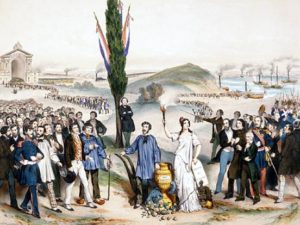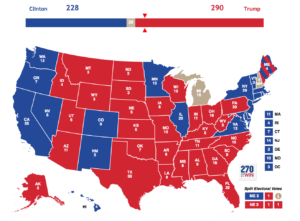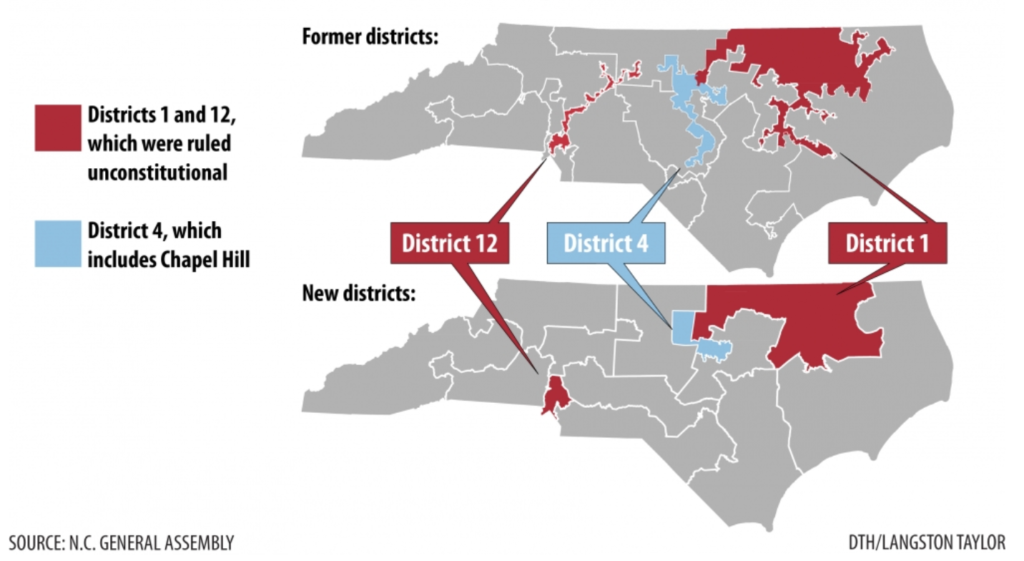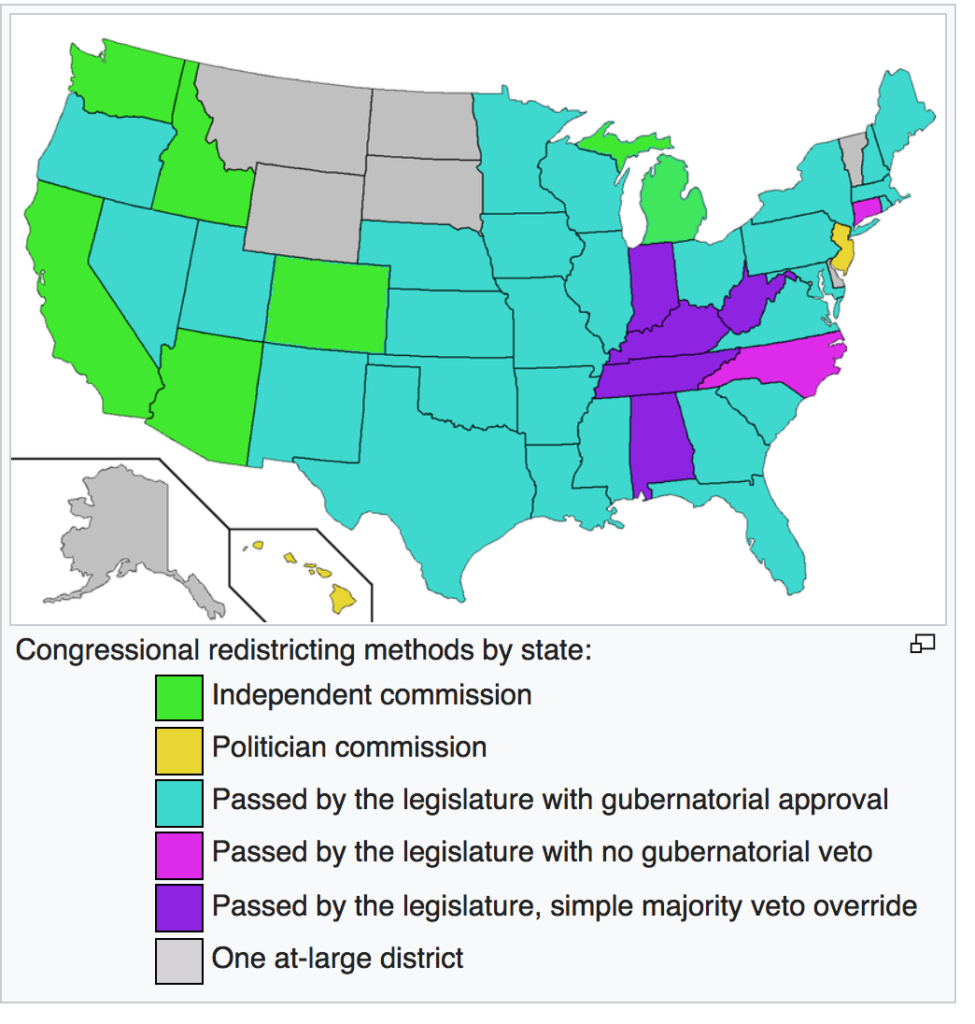
The View:
Once again our presidential election process failed to give our people a popularly voted president. Donald Trump received 290 electoral votes to Hillary Clinton’s 228, yet she won the popular vote by 1,575,000 votes. This situation has caused protests, fear, anxiety and sense of injustice across the country. The Electoral College was developed by the founders as a way to make the Office of the President a powerful branch of government, not beholding to the majority of representatives in Congress. They developed a state based election system where presidential electors were allocated by state for each senator and congressional representative. With this election there has been 6 times in the history of this country that a president was elected who did not receive the most popular votes. This outcome is completely undemocratic, and makes a non-popular voted president illegitimate in the minds of many people. Alternatives for establishing a popular vote for president require a Constitutional amendment which is extremely difficult to accomplish. The approach most likely to succeed is to ask state legislatures to follow the lead of Nebraska an Maine and allocate their electors by congressional district with the two senator representatives elected at large. This congressional district allocation can be accomplished by the state legislatures without a change to the Constitution. The Action would be be to file suit in federal court finding that the present system violates one man – one vote provision of the Constitution, thereby forcing the states to redistribute their electors by another method preferably by congressional district. Persuading leading states like California, New York, Illinois, Texas and Florida to do this would likely influence the other states to go along. Finally, a National Popular Vote Interstate Compact has gained momentum to have states by law allocate their electors to the national popular vote candidate.
The Story:
This author asked his mother when he turned 18 years old, ‘how do you vote for President?’ she replied, ‘I think of the President like a child with a hammer, how much damage can he do, so I vote for the least damage.” With that approach the country has just given our 45th President a hammer with a box of toys to break!
Why do we have the Electoral College anyway? The founding fathers had just come from a monarchy based government, so they did not what to repeat a system of a proclaimed leader (everyone wanted George Washington to be President at the time) with the leader appointing the next in succession. Another approach under consideration was to have a national leader based on representational majority in Parliament. Yet, they believed in balancing the powers of Congress and the Executive branch. Plus, the founders were looking for a way to motivate the President for good behavior by allowing a second term. If the President were elected by Congress it would have to be for one term, or he would become a tool of the majority in Congress. They did not want a direct popular vote because they were concerned that a national constituency could not be developed with so many regions and states likely to have favorite son candidates. James Madison, Constitution Convention recorder and leader, was looking for a compromise because southern states felt they would lose out a national constituency with blacks being 3/5 of a citizen. So, a compromise was established to have a set of electors voted on by the people in each state based on popular vote. These electors that would then vote in a separate Electoral College vote in December with ballots read in a session of Congress. If there was a tie 269 – 269 of electors between candidates, then Congress would vote on who would become President. In our history there have been 5 Presidents who have not won the popular vote but have won by electors. Our election this past week is the latest example, where Hillary Clinton won the popular vote by over 575,000 votes over Donald Trump. Yet she come up short in electoral votes based on state representation, Clinton has 228 to Trump’s 290 (some states still counting).
Why is this a problem? The popular vote and will of the people is thwarted. A major issue is that the Electoral College is not one person – one vote as identified in our Constitution for a representative democracy. A vote in California with 55 electoral votes and 8,458,000 citizen votes means that one electoral vote represents 153,781 citizens. In Wyoming, with 3 electoral votes and 230,197 citizen votes means that one electoral vote equals 76,732 citizen votes. A voter in Wyoming enjoys twice as powerful citizen/electoral vote than a citizen in California. The balance of power in the Electoral College swings to mostly lower population inland states deciding who our president will be. In this election inequitable voting power certainly is true when you look at an electoral map (right click on image to enlarge):

This voting power inequity creates great frustration and anger. In the last few days, we have seen protests in 37 cities across the country against the president elect due to the injustice of the non-popular vote. All our representative government functions are based on majority vote from local city councils to state legislatures and the US Congress. It only makes sense to have a popular vote for president in the modern era. With growing economic inequality and divisive politics particularly between inland populations and coastal cities a fair vote for president would go a long way toward building a united country.
The Solution:
Why not just have a direct popular vote? This would be a good solution except that the Constitution needs to be changed in a two-step process by creating an amendment followed by ratification. The US Congress can create an amendment by a two-thirds vote of the House and Senate or two thirds of the state legislatures. The proposed amendment then must be ratified by three-fourths of the state legislatures in a time frame approved by Congress. This is a long and difficult process as 11,539 amendments have been introduced in Congress since 1789 and 27 have become part of the US Constitution.
How about apportioning electors by congressional district? We already portion congressional districts by population which is updated in each decade by the Census. This approach provides some equity for citizen to elector representation – though it will not fix the inequality completely due to the two senate electors. Maine and Nebraska apportion their electors by congressional districts today, with their two senatorial electors representing a statewide vote. This congressional districting would be fair and take care of 80 % of the vote inequity issue. Plus, candidates would need to focus their campaigning on congressional districts not the whole state for a winner take all result. For example, California rarely sees presidential candidates from either party for the presidential race because it has gone for the Democratic candidate in the last 6 elections.
It would be good to have congressional districts mapped by an independent commission as California does to ensure that the district is open to diverse political viewpoints. By establishing congressional districts as the key representative unit with fair boundaries for inclusion of multiple points of view we might see more dialog at the local level. The increased dialog will induce more consensus building and possibly break the grasp of incumbents who are re-elected 93 % of the time. State legislatures can decide on their manner of apportioning electors – so we could build a national census to have the states enact changes by the 2020 election.
A popular vote approach campaign is lead by the Democracy for Action (DFA), called the National Popular Vote Interstate Compact. Whereby, states legislatures would agree to vote their electors for the winner of the popular vote. This compact would take effect when at least 270 electoral votes would be covered. To date ten state legislatures have ratified this approach, swing states are reluctant to make the switch, though after the 2016 election there maybe more of a push to make this system happen.
The Action:
- File suit in federal court (which would probably go to the Supreme Court) to find that present Electoral College process violated the one man – one vote finding of the Supreme Court for the 2016 election. Winning a suit would force the states to rewrite their present distribution of electors.
- Implement a national program to influence state legislatures in the other 48 states (Maine and Nebraska already use congressional districts) to distribute electors by congressional district popular vote. Influence leading states with the most electors to switch to a congressional district approach like California, New York, Illinois, Texas, and Florida. The other states will follow their lead.
- Finish obtaining the support of more states for the National Popular Vote Interstate Compact for 270 electoral votes. There is a petition being emailed to progressives by DFA, sign and donate to their campaign effort.
(Editor Note: References appear under the Research tab)
Update: Gerrymandering for Partisanship Found Unconstitutional – November 22, 2016
A Federal Court in Wisconsin has found that GOP gerrymandering of state legislature districts was giving unfair advantage to Republicans over Democrats. It is the first time in pitched battles over the past 30 years that federal courts have looked at partisanship as a constitutional issue. The ruling offered a clear mathematical formula for evaluating partisanship, called the efficiency gap model. The model proposed by plaintiffs divides the difference between the two parties wasted votes (beyond those needed by the winning side) and the votes cast by the losing side by the total number of votes. Zero is the ideal situation. The GOP had a very high score versus the average, so it was quite evident to the court that an unfair bias was used in drawing district lines. Representation districts are redrawn every 10 years after the Census to ensure each district contains roughly the same number of people based on the one man – one vote decision by the Supreme Court in 1962. Note we suggested a law suit on very similar grounds in The Action above, this is a good start, now to take this case to the Supreme Court to force state legislatures to redraw districts in a more balanced way. This is crucial to reduce partisanship, open dialog and fairly allocate representation regardless of party. For more details go to this article in the NY Times.




